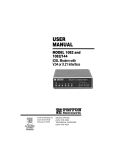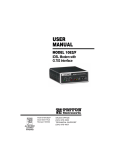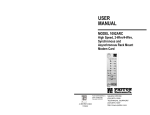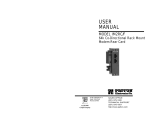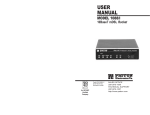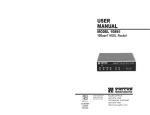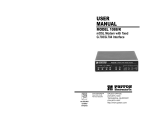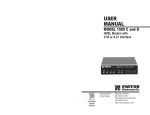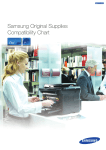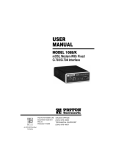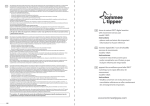Download Patton electronic 1082/I Network Card User Manual
Transcript
USER MANUAL MODEL 1082/I and 1082/144/I iDSL Modem with 10Base- T Interface Part# 07M1082/I-B Doc# 033181UB Revised 7/13/01 CERTIFIED An ISO-9001 Certified Company SALES OFFICE (301) 975-1000 TECHNICAL SUPPORT (301) 975-1007 TABLE OF CONTENTS 1.0 1.1 1.2 1.3 Warranty Information .................................................................. 4 FCC Information ........................................................................... 4 CE Notice...................................................................................... 4 Service.......................................................................................... 5 2.0 2.1 2.2 2.3 General Information..................................................................... 6 Features........................................................................................ 6 Description.................................................................................... 7 1082 SNMP Management Solutions............................................. 7 HTTP/HTML Management ........................................................... 7 3.0 3.1 PPP Operational Background..................................................... 8 Applications .................................................................................. 8 4.0 4.1 Configuration ............................................................................. 11 Configuring the Hardware DIP Switches .................................... 11 Configuring DIP Switch S1 ......................................................... 12 Switches S1-1 and S1-2: Data Rate........................................... 13 Switch S1-5: Asynchronous/Sync Operation.............................. 13 Switches S1-6 and S1-7: System Clock Mode ........................... 14 Switch S1-8: Response to RDL Request.................................... 14 Configuring DIP switch “S2” ....................................................... 15 Switches S2-1: 19.2 kbps or 144* kbps Synchronous Rate Enable.......................................................... 15 Switch S2-2: Front Panel Switch Disable ................................... 16 Switches S2-3, S2-6, S2-7 and S2-8: Reserved ........................ 16 5.0 5.1 5.2 5.3 5.4 Installation.................................................................................. 17 Connecting DSL Interface........................................................... 17 Connecting 10Base-T Ethernet Port to PC (DTE) ...................... 18 Connecting 10Base-T Ethernet Port to Hub (DCE) .................... 18 Power Connection ...................................................................... 19 Universal AC Power (100–240VAC)........................................... 19 DC Power ................................................................................... 20 6.0 6.1 6.2 6.3 Operation.................................................................................... 21 Power-up .................................................................................... 21 LED Status Monitors................................................................... 21 Test Modes ................................................................................. 23 Remote Digital Loopback (RDL)/V.52 (BER).............................. 23 A A.1 A.2 A.3 A.4 A.5 A.6 A.7 1082/I Specifications ................................................................. 25 Transmission Format ...................................................................25 Transmission Line ........................................................................25 Clocking .......................................................................................25 Distance .......................................................................................25 Data Rates ...................................................................................25 Diagnostics ..................................................................................25 LED Status Indicators ..................................................................25 2 A.8 A.9 A.10 A.11 A.12 A.13 A.14 Connectors ..................................................................................25 Power ...........................................................................................25 Temperature Range .....................................................................26 Altitude .........................................................................................26 Humidity .......................................................................................26 Dimensions ..................................................................................26 Weight ..........................................................................................26 B Model 1082/I Factory Replacement Parts and Accessories ........................................................................ 27 3 1.0 WARRANTY INFORMATION Patton Electronics warrants all Model 1082/I and Model 1082/144/I components to be free from defects, and will—at our option—repair or replace the product should it fail within one year from the first date of shipment. This warranty is limited to defects in workmanship or materials, and does not cover customer damage, abuse or unauthorized modification. If this product fails or does not perform as warranted, your sole recourse shall be repair or replacement as described above. Under no condition shall Patton Electronics be liable for any damages incurred by the use of this product. These damages include, but are not limited to, the following: lost profits, lost savings and incidental or consequential damages arising from the use of or inability to use this product. Patton Electronics specifically disclaims all other warranties, expressed or implied, and the installation or use of this product shall be deemed an acceptance of these terms by the user. 1.1 FCC INFORMATION This equipment has been tested and found to comply with the limits for a Class A digital device, pursuant to Part 15 of the FCC Rules. These limits are designed to provide reasonable protection against harmful interference when the equipment is operated in a commercial environment. This equipment generates, uses, and can radiate radio frequency energy and, if not installed and used in accordance with the instruction manual, may cause harmful interference to radio communications. Operation of this equipment in a residential area is likely to cause harmful interference in which case the user will be required to correct the interference at his own expense. If this equipment does cause harmful interference to radio or television reception, which can be determined by turning the equipment off and on, the user is encouraged to try to correct the interference by one or more of the following measures: • Reorient or relocate the receiving antenna • Increase the separation between the equipment and receiver • Connect the equipment into an outlet on a circuit different from that to which the receiver is connected 1.2 CE NOTICE The CE symbol on your Patton Electronics equipment indicates that it is in compliance with the Electromagnetic Compatibility (EMC) directive and the Low Voltage Directive (LVD) of the Union European (EU). A Certificate of Compliance is available by contacting Patton Technical Support. 4 1.3 SERVICE All warranty and non-warranty repairs must be returned freight prepaid and insured to Patton Electronics. All returns must have a Return Materials Authorization number on the outside of the shipping container. This number may be obtained from Patton Electronics Technical Service at: Tel: (301) 975-1007 E-mail: [email protected] URL: www.patton.com Note Packages received without an RMA number will not be accepted. Patton Electronics’ technical staff is also available to answer any questions that might arise concerning the installation or use of your Model 1082/I or Model 1082/144/I. Technical Service hours: 8AM to 5PM EST, Monday through Friday. 5 2.0 GENERAL INFORMATION Thank you for your purchase of this Patton Electronics product. This product has been thoroughly inspected and tested and is warranted for One Year parts and labor. If any questions or problems arise during installation or use of this product, please do not hesitate to contact Patton Electronics Technical Support at (301) 975-1007. 2.1 FEATURES • Provides MAC Level Data Link (Layer 2) connection between two peered 10Base-T Ethernet LANs • Operates transparently to higher level protocols such as TCP/IP, DECnet, NETBIOS and IPX • PPP (Point to Point Protocol, RFC 1661) with Bridge Control Protocol (RFC 1638) • Automatically learns, loads and removes MAC addresses • Point-to-point distances up to 5 miles (all data rates) on 24 AWG twisted pair • HTTP/SNMP Manageable as CP (Customer Premises) Unit with 1092ARC CO (Central Office) Rack Card and 1001MC management card • Internal or receive recovered clocking between units • LED indicators for 10Base-T Link, DSL Link, Status, No Signal, Error and Test Mode • Remote digital loopback, local line loopback diagnostic modes • Synchronous data rates: 19.2, 32, 56, 64, 128, and 144 kbps Note 144 kbps data rate is only available on the Model 1082/144/I. 19.2 kbps rate is available on all Model 1082 series modems except for the 1082/144/I. • Full duplex operation over a single twisted pair (2-wires) • Multi-Rate Symmetric DSL • Compatible with the popular Patton Model 1092A • Universal power supply (90–260VAC) or DC power supply (-48VDC) • Small, Convienent Desktop Unit • CE Marked 6 2.2 DESCRIPTION The Model 1082/I and Model 1082/144/I are Multi Rate iDSL Modems that provide seamless MAC Layer connectivity between 2 peered 10Base-T LANs. Now, Enterprise users no longer need to hassle with a bridge and a CSU/DSU or recurring leased line costs. The 1082 allows users to add additional nodes to a LAN that has reached its maximum distance limits or separate high traffic areas of a LAN. The 1082 connects peered LANs and automatically forwards and receives LAN broadcasts, multi-casts and frames across a 2-wire DSL span. The Model 1082/I and Model 1082/144/I support PPP (RFC 1s661) and BCP (RFC 1638). Both 1082 modems’ features include loopback diagnostics, inband SNMP/HTTP remote management capabilities using NetLink Plug-andPlay and externally accessible configuration switches. As a symmetric DSL modem, the1082 offers the same data rates in both directions over a single pair of regular telephone lines using 2BIQ modulation. The 1082 connects to the DSL line via an RJ-45 jack, and is powered by a universal (90–260VAC) supply or a DC supply (-48VDC). 2.3 1082 SNMP MANAGEMENT SOLUTIONS The Model 1082/I and Model 1082/144/I are SNMP manageable when connected to a rack-mounted Model 1092ARC (see Figure 1). SNMP management is enabled through a 1001MC rack management card located in the Patton Electronics Rack System. Model 1082 10Base-T connection to 1001MC 2B1Q connections to remote 1082s Management Station Model 1082 Rack-mounted 1092ARCs Figure 1. Typical application HTTP/HTML Management The 1001MC maintains HTML pages that can be viewed through a Web browser. You can display remote statistics and configure Model 1082 parameters simply by entering the 1001MC’s IP address into the browser. 7 3.0 PPP OPERATIONAL BACKGROUND PPP is a protocol used for multi-plexed transport over a point-to-point link. PPP operates on all full duplex media, and is a symmetric peer-topeer protocol, which can be broken into three main components: • A standard method to encapsulate datagrams over serial links • A Link Control Protocol (LCP) to establish, configure, and test the data-link connection • A family of Network Control Protocols (NCPs) to establish and configure different network layer protocols In order to establish communications over a point-to-point link, each end of the PPP link must first announce its capabilities and agree on the parameters of the link’s operation. This exchange is facilitated through LCP Configure-Request packets. Once the link has been established and optional facilities have been negotiated, PPP will attempt to establish a network protocol. PPP will use Network Control Protocol (NCP) to choose and configure one or more network layer protocols. Once each of the network layer protocols have been configured, datagrams from the established network layer protocol can be sent over the link. The link will remain configured for these communications until explicit LCP or NCP packets close the link down, or until some external event occurs. The PPP Bridging Control Protocol (BCP), defined in RFC 1638, configures and enables/disables the bridge protocol on both ends of the pointto-point link. BCP uses the same packet exchange mechanism as the Link Control Protocol (LCP). BCP is a Network Control Protocol of PPP, bridge packets may not be exchanged until PPP has reached the network layer protocol phase. 3.1 APPLICATIONS In situations where a routed network requires connectivity to a remote Ethernet network, the interface on a router can be configured as a PPP IP Half Bridge. The serial line to the remote bridge functions as a Virtual Ethernet interface, effectively extending the routers serial port connection to the remote network. The bridge device sends bridge packets (BPDU’s) to the router's serial interface. The router will receive the layer three address information and will forward these packets based on its IP address. 8 Patton 1082/C connected to a router Patton 1082/I Bridge Ethernet LAN PEC device with serial interface Figure 2. Cisco router with serial interface, configured as PPP Half-Bridge Figure 2 shows a typical Cisco router with a serial interface configured as a PPP Half Bridge. The router serial interface uses a remote device that supports PPP bridging to function as a node on the remote Ethernet network. The serial interface on the Cisco will have an IP address on the same Ethernet subnet as the bridge. For example, the customer site is assigned the addresses 192.168.1.0/ 24 through 192.168.1.1/24. The address 192.168.1.1/24 is also the default gateway for the remote network. The above settings remove any routing/forwarding intelligence from the CPE. The associated Cisco configuration will set serial interface (s0) to accommodate half bridging for the above example. Authentication is optional under PPP. In a point-to-point leased-line link, incoming customer facilities are usually fixed in nature, therefore authentication is generally not required. If the foreign device requires authentication via PAP or CHAP, the PPP software will respond with default PeerID consisting of the units Ethernet MAC address and a password which consists of the unit’s Ethernet MAC address. Some networking systems do not define network numbers in packets sent out over a network. If a packet does not have a specific destination network number, a router will assume that the packet is set up for the local segment and will not forward it to any other sub-network. However, in cases where two devices need to communicate over the wide-area, bridging can be used to transport non-routable protocols. 9 Figure 3. Transparent bridging between two routers over a serial interface Figure 3 illustrates transparent bridging between two routers over a serial interface (s0). Bridging will occur between the two Ethernet interfaces on router A (e0 and e1) and the two Ethernet interfaces on router B (e0 and e1). 10 4.0 CONFIGURATION The Model 1082/I and Model 1082/144/I each are equipped with 16 DIP switches that enable configuration of the unit for a wide variety of applications. This section describes switch locations and explains the different configurations. 4.1 CONFIGURING THE HARDWARE DIP SWITCHES Using a small flat-tip screwdriver, remove the protective cover located on the underside of the Model 1092 (see Figure 4). /G l1 03 de G.7s NS tu Link Sta BT L 10 DS Mo 19 4E Sin gle od tM es M 4T T .70 ER Mo de Fib 51 1E es 5 D N 1/R 51 em od 4L M .7S0 /GiD a0s3tT 0B.7 BL d1G /R uak 1E Qin - tL 51 al eNr e 11 orm L Figure 4. Removing the cover to access DIP switches S1 and S2 11 S1 S2 S2 ON ON 1 2 3 4 5 6 7 8 1 2 3 4 5 6 7 8 S1 S1 Switch toggle ON 1 2 3 4 5 6 7 8 Push toggle up ON for ON position 1 2 3 4 5 6 7 8 1 2 S1 Push toggle down for OFF position ON Figure 5. DIP switches S2 and S2 Figure 5 shows the orientation of the DIP switches in the “ON” and “OFF” positions. Configuring DIP Switch S1 DIP switch S1 is where you configure the data rate, asynchronous or synchronous data format, transmit clock source, and response to RDL request. The following table summarizes default positions of DIP switches S1-1 through S1-8. Detailed descriptions of each switch follow the table. Position S1 Summary Table Function S1-1 Data Rate On S1-2 Data Rate Off S1-3 Reserved On Factory Default S1-4 Reserved On S1-5 Async/Sync Data Format Off S1-6 Tx Clock Source On S1-7 Tx Clock Source On S1-8 Response to RDL Request On 12 } 64K Sync Async/Sync } Internal Clock Enable Note When setting the 1082 for SNMP Management, the DTE rate switches (S1-1,S1-2, and S2-1) must be also set to the ON position. Therefore, to set a 1082 unit SNMP Mangagement mode, the following switches have to be at the ON position, S1-1, S1-2, S2-1. Switches S1-1 and S1-2: Data Rate Use switches S1-1 and S1-2 to configure the asynchronous or synchronous data rate of the Model 1082/I and Model 1082/144/I. Each setting represents one synchronous data rate and one asynchronous data rate. S1-1 S1-2 Sync Data Rate Async. Data Rate On Off On Off Off On On Off Off Off 32 kbps 56 kbps 64 kbps 128 kbps (see note) 144 kbps or 19.2 kbps (see note) Reserved Reserved Reserved 0–38.4 kbps Reserved Note The Model 1082/I can also operate at the 19.2 kbps synchronous rate, and the Model 1092/144/I can also operate at the 144 kbps synchronous rate. To operate at these rates, set Switches S1-1 and S1-2 both to the OFF position and Switch S2-1 to the ON position (see “Configuring DIP switch “S2”” on page 152 for a description of Switch S2-1). If the S2-1 switch is positioned in the OFF position, the 128 kbps sync data rate/0–38.4 kbps async data rate option is selected. Switch S1-3 and S1-4: Must be set to the ON position (Reserved). S1-3 Setting S1-4 Setting On Reserved On Reserved Switch S1-5: Asynchronous/Sync Operation Use Switch S1-5 to configure the Model 1082 for async/sync operation. Switch S1-5 must be set in the Off position. There is no other valid setting. S1-5 Setting Off Async/Sync 13 Switches S1-6 and S1-7: System Clock Mode Use Switches S1-6 and S1-7 to configure the 1082/I or Model 1082/144/ I for internal, or receive recover clock mode. S1-6 S1-7 Clock Mode Description On On On Off Internal Receive Recover System clock generated internally System clock derived from the received line signal Off Off Hardware Reset Important A pair of Model 1082/Is communicate synchronously across the twisted pair line connection. Therefore, you must set these switches whether your application is async or sync. For Sync or Async applications, please configure one Model 1082/I for internal clock mode and the other Model 1082/I for receive recover clock mode. Switch S1-8: Response to RDL Request Use Switch S1-8 to allow Model 1082/I and Model 1082/144/I to enter the Remote Digital Loopback diagnostic test when requested to do so by the far end Model 1082/I and Model 1082/144/I. For example, when switch S18 is set to “ON”, it will enter RDL mode (See section 6.3, “Test Modes” on page 23) when requested to do so by the remote Model 1082/I and Model 1082/144/I. Note S1-8 Setting On Off Response to RDL Request Enabled Response to RDL Request Disabled The Remote Digital Loopback (RDL) will not work for 144 kbps. You must first set the units to 128 kbps or slower to use the RDL. 14 Configuring DIP switch “S2” Use the eight DIP switches in S2 to enable 19.2 kbps or 144* kbps synchronous operation and set the loopback modes. The following table summarizes default positions of DIP switches S2-1 through S2-8. Detailed descriptions of each switch follow the table. Position S2 Summary Table Function S2-1 19.2 or 144* kbps Enable Off S2-2 Front Panel Switch Disabl e Off S2-3 Reserved Off S2-4 Reserved Off S2-5 Reserved Off S2-6 Reserved On S2-7 Reserved Off S2-8 Reserved Off Factory Default Switches S2-1: 19.2 kbps or 144* kbps Synchronous Rate Enable Use switch S2-1 to allow the Model 1082/I and Model 1082/144/I to operate at the 19.2 kbps synchronous data rate, or to enable the Model 1082/ 144/I to operate at the 144* kbps synchronous data rate. S2-1 Activation Description Off Disabled On Enabled Synchronous data rate is 32–128 kbps as defined by switches S1-1 and S1-2 Model 1082/I operates at synchronous 19.2 kbps data rate (see note). The Model 1082/144/I operates at 144 kbps synchronous data rate (see note) Note * To operate at 19.2 kbps or 144 kbps, set switches S1-1 and S1-2 to the OFF position and switch S2-1 to ON (see section “Configuring DIP Switch S1” on page 12). 144 kbps data rate is only available on the Model 1082/144/I. 19.2 kbps rate is available on all Model 1082 series modems except for the 1082/144/I. 15 Switch S2-2: Front Panel Switch Disable Use switch S2-2 to enable or disable the front panel toggle switches. S2-2 Setting On Off Disable the front panel switches Enable the front panel switches Switches S2-3, S2-6, S2-7 and S2-8: Reserved 16 5.0 INSTALLATION When the Model 1082 has been properly configured, it may be connected to the DSL twisted pair interface, the 10Base-T Ethernet Interface, and the power source. This section describes these connections. Interface connector ON Made in the USA | Power OFF O DSL interface Interface DSL Power input connector Mo G.7 Po de wel 11 r 9 4E 03 Sin /G gle .70 4T es Mo de 5M1 tM od a1dE e in es DSFib L er - the US A Qu ad G.7 03 /G.7 04 InteMo rfadem ce Figure 6. Model 1082/I or Model 1082/144/I rear view 5.1 CONNECTING DSL INTERFACE The Model 1082 supports communication between 10Base-T Hubs or Workstations at distances to 5 miles (8 km) over 24 AWG (.5mm) twisted pair wire. There are two requirements for installing the Model 1082: • These units operate as a pair. Both units at the end of the twisted pair DSL span must be set for the same DTE rate. • To function properly, the Model 1082 needs one twisted pair of metallic wire. This twisted pair must be unconditioned, dry, metallic wire, between 19 (.9mm) and 26 AWG (.4mm) (the higher number gauges will limit distance). Standard dial-up telephone circuits, or leased circuits that run through signal equalization equipment, or standard, flat modular telephone type cable, are not acceptable. 17 The RJ-45 connector on the Model 1082’s twisted pair interface is polarity insensitive and is wired for a two-wire interface. The signal/pin relationships are shown in Figure 7 below. Figure 7. Model 1082/I twisted pair line interface 5.2 CONNECTING 10BASE-T ETHERNET PORT TO PC (DTE) The 10Base-T interface is configured as DTE (Data Terminal Equipment). If the Model 1088 is to to connect to another DTE device such as a 10Base-T network interface card, construct a 10Base-T crossover cable and connect the wires as shown in Figure 8. 10Base-T Port RJ-45 Pin No. 1 (TD+) 2 (TD-) 3 (RD+) 6 (RD-) 10Base-T DTE RJ-45 Pin No. 1 (TD+) 2 (TD-) 3 (RD+) 6 (RD-) Figure 8. Connecting 10Base-T Ethernet port to PC 5.3 CONNECTING 10BASE-T ETHERNET PORT TO HUB (DCE) The 10Base-T interface is configured as DTE (Data Terminal Equipment), just like a 10Base-T network interface card in a PC. Therefore, it “expects” to connect to a 10Base-T Hub using a straight-through RJ-45 cable. Figure 9 shows how to construct a cable to connect the 10Base-T interface to a 10Base-T Hub. 10Base-T Port RJ-45 Pin No. 1 (TD+) 2 (TD-) 10Base-T Hub RJ-45 Pin No. 1 (TD+) 2 (TD-) 3 (RD+) 6 (RD-) 3 (RD+) 6 (RD-) Figure 9. Connecting the 10Base-T interface to a 10Base-T Hub 18 5.4 POWER CONNECTION Universal AC Power (100–240VAC) The Model 1082/I uses a 5VDC, 2A universal input 100–240VAC, power supply (center pin is +5V). The universal input power supply has a male IEC-320 power entry connector. This power supply connects to the Model 1082/I by means of a barrel jack on the rear panel. Many international power cords are available for the universal power supply. Please refer to Appendix B for country-specific power cords. The Model 1082/I powers up as soon as it is plugged into an AC outlet. The Model 1082/I does not have a power switch. 19 DC Power The DC adapter supplied with the DC version of the model 1082/I plugs in a DC source (nominal 48VDC) and plugs into the barrel power supply jack on the rear of the 1082/I. Refer to Figure 10 below to make the proper connection. To Power Supply Jack -Vin To -48VDC Source +Vin Figure 10. Power adapter There are no user-serviceable parts in the power supply section of the Model 1082/I. Contact Patton Electronics Technical support at +1 (301) 975-1007, via our web site at www.patton.com, or by E-mail at [email protected], for more information. WARNING 20 6.0 OPERATION When the Model 1082/I and Model 1082/144/I have been properly configured and installed, it should operate transparently. This sections describes power-up, LED status monitors, and the built-in loopback test modes. 6.1 POWER-UP Before applying power to the Model 1082/I or Model 1082/144/I, please read section 5.4, “Power Connection” on page 19 and ensure that the unit is connected to the appropriate power source. 6.2 LED STATUS MONITORS The Model 1082/I and Model 1082/144/I feature six front panel LEDs that monitor connections on the DSL and 10Base-T links, signaling, error and test modes. (See Figure 11 for front panel location of each LED). Descriptions of each LED follow in Table 1 on page 22. NetLink™ 10Base-T iDSL Model Link DSL 10BT DSL NS ER TM NS 10BT ER 511E/RDL Normal 511/RDL TM Loopback switch Figure 11. Model 1082/I or 1082/144/I front panel LED locations 21 Table 1: LED status monitor indications LED Description DSL Link (Active Green) Solid green (On) indicates that the end to end DSL Framer Link is up, signifying that the link across the DSL span is active. The DSL Link LED is Off when the link is down. Blinks yellow from one to eleven times to indicate system status. Each pulse pattern is separated by a 2 second “off” period. Greater pulse patterns have higher priority (buffer saturation has greater priority than an empty MAC table). Valid system statuses are: Status • 1 pulse—system status is okay • 2 pulses—no MAC entries in the MAC Address Table • 3 pulses—Clear to Send (CTS) or Carrier Detect (DCD) from base unit are not asserted • • • • • • • 4 pulses—IM1/I buffer is saturated 5 pulses—WAN receive frame(s) too large 6 pulses—WAN receive frame(s) not octet aligned 7 pulses—WAN receive frame(s) aborted 8 pulses—Detected WAN receive frame(s) with CRC 9 pulses—Detected LAN receive frame(s) too large 10 pulses—Detected LAN receive frame(s) not octet aligned • 11 pulses—Detected LAN receive frame(s) with bad 10BT Link NS ER TM CRC (Active green) Solid green indicates that the 10Base-T Ethernet interface has detected a valid SQE heartbeat, signifying a valid 10Base-T connection (Active red) Solid red indicates that the Digital Signal Processors (DSPs) are not linked (Active red) Flashing red indicates CRC errors on DSL (framer) side if DSL Link is active or if bit errors are received during loop/BER test ER flashes once, to indicate a CRC error (during normal operation) or bit errors (during Remote Loopback 511/511E tests) (Active yellow) Solid yellow indicates an Active Test Mode. The unit may be placed in test mode by the local user or by the remote user. 22 Table 2: LED configurations LOCAL Power ON REMOTE 10Base-T DSL Status NS ER TM 10Base-T DSL Status NS ER TM G* off F on off off G* off F O N off off DSL Link G* G F off off off G* off F off off off Link Brk G* off F off off off G* off F off off off Brk+ 10s G* off F ON off off G* off F O N off off RDL G* G F off off ON G* off F off off ON RDL+511 G* off F off off ON G* off F off off ON Mark G* G F off off off G* G F off off off Space G* G F off off off G* G F off off off Data G* G F off off off G* G F off off off With DTE Connected With DTE Connected G=GREEN O=ORANGE ON= ON off= OFF Brk+10s = 10 Seconds following Link Break G*=Green if a valid 10Base-T connection is detected. F=Flashing Link Brk = DSL Link Broken 6.3 TEST MODES The Model 1082/I and Model 1082/144/I has a built-in proprietary loopback test mode, plus a built-in V.52 BER test pattern generator, for evaluating the condition of the modems and the communication link. These tests can be activated physically from the front panel, or via the interface. Remote Digital Loopback (RDL)/V.52 (BER) The Remote Digital Loopback (RDL) test checks the performance of both the local and remote Model 1082s, and the communication link between them. Any characters sent to the remote Model 1082 in this test mode will be returned back to the originating device (see Figure 7, below). For example, characters typed on the keyboard of the local terminal will appear on the local terminal screen after having been passed to the remote Model 1082 and looped back. Local 1082 Remote 1082 RDL initiated Figure 12. Remote digital loop 23 Do not send a 511 test pattern from the test equipment when you connect external test equipment to the 1082. Important Activating RDL can be done in two ways: 1. Move the front panel toggle switch to appropriate position. 2. Set remote loopback from SNMP screen (when used with 1092ARC Rack Card) Note Remote loopback cannot be activated until approximately 45 seconds after the two modems have linked to each other. Note The Remote Digital Loopback (RDL) will not work for 144 kbps. You must first set the units to 128 kbps or slower to use the RDL. To use the V.52 BER tests with the Remote Digital Loopback tests, do the following: 1. Locate the 511/RDL toggle switch on the front panel of the 1082/I and move it DOWN. This initiates the RDL and sends a 511 pattern into the loop. If any errors are present, the local modem’s red “ER” LED will blink continually. 2. If the above test indicates no errors are present, move the V.52 toggle switch UP, activating the 511E/RDL test with errors present. If the test is working properly, the local modem's red “ER” LED will blink approximately once per second. A successful 511E/RDL test will confirm that the link is in place, and that the Model 1082’s built-in “511” generator and detector are working properly. 24 APPENDIX A 1082/I Specifications A.1 TRANSMISSION FORMAT Synchronous or asynchronous A.2 TRANSMISSION LINE Single unconditioned twisted pair A.3 CLOCKING Internal or receive loopback A.4 DISTANCE 2-Wire Distance Table in miles (km) AWG Wire Gauge (mm) Data Rate All rates 19 (.9) 22 (.6) 24 (.5) 6 (.4) 10.8 (17.2) 7.2 (11.5) 5.0 (8.0) 3.4 (5.5) A.5 DATA RATES Synchronous 19.2, 32, 56, 64, and 128 kbps, (and 144 kbps on 1082/144 only); Asynchronous 0–38.4 kbps A.6 DIAGNOSTICS V.52 compliant bit error rate pattern (511/511E pattern) generator and detector with error injection mode; Local Line Loopback and Reomote Digital Loopback, activated by front panel switches or via serial interface. A.7 LED STATUS INDICATORS DSL, 10Base-T, Status, NS (no signal), ER (error) and TM (test Mode) A.8 CONNECTORS RJ-45 on line side; shielded RJ-45 on Ethernet port A.9 POWER 100–253 VAC, 50–60 Hz (universal input option); 48 VDC (optional), 5 watts 25 A.10 TEMPERATURE RANGE 32–122°F (0–50°C) A.11 ALTITUDE 0–15,000 feet (0–4,572 meters) A.12 HUMIDITY 5–95% non-condensing A.13 DIMENSIONS 4.125W x 1.625H x 6.0D in. (10.5W x 4.1W x 15.2D cm) A.14 WEIGHT 2.01 lbs. (1.0 kg) 26 APPENDIX B MODEL 1082/I FACTORY REPLACEMENT PARTS AND ACCESSORIES Model # Description 1082/I 1082/144/I 10Base-T, DSL Modem 10Base-T DSL modem with maximum data rate of 144 kbps 48V-PSM 08055DCUI DC Power Supply Module 100-240VAC (+5V ±5% reg. DC/2A) Universal Input Adapter 0805EUR 0805UK 0805US 0805AUS 0805DEN 0805FR 0805IN 0805IS 0805JAP 0805SW European Power Cord CEE 7 (“A”) United Kingdom Power Cord (“D”) American Power Cord (“K”) Australia/New Zealand Power Cord (“C”) Denmark Power Cord (“E”) France/Belgium Power Cord (“F”) India Power Cord (“G”) Israel Power Cord (“H”) Japan Power Cord (“J”) Switzerland Power Cord (“L”) 07M1082 User Manual 27 Notes _________________________________________________________ _________________________________________________________ _________________________________________________________ _________________________________________________________ _________________________________________________________ _________________________________________________________ _________________________________________________________ _________________________________________________________ _________________________________________________________ _________________________________________________________ _________________________________________________________ _________________________________________________________ _________________________________________________________ _________________________________________________________ _________________________________________________________ _________________________________________________________ _________________________________________________________ _________________________________________________________ _________________________________________________________ _________________________________________________________ _________________________________________________________ Copyright © 1998, 2001 Patton Electronics Company All Rights Reserved. 28




























